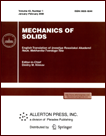 | | Mechanics of Solids
A Journal of Russian Academy of Sciences | | Founded
in January 1966
Issued 6 times a year
Print ISSN 0025-6544
Online ISSN 1934-7936 |
Archive of Issues
| Total articles in the database: | | 13362 |
| In Russian (Èçâ. ÐÀÍ. ÌÒÒ): | | 8178
|
| In English (Mech. Solids): | | 5184 |
|
| << Previous article | Volume 60, Issue 3 / 2025 | Next article >> |
| Che-Yu Lin and Yi-Ju Chou, "Investigating the Role of Burgers Model for Both Viscoelastic Liquids and Solids," Mech. Solids. 60 (3), 2272-2288 (2025) |
| Year |
2025 |
Volume |
60 |
Number |
3 |
Pages |
2272-2288 |
| DOI |
10.1134/S0025654425600059 |
| Title |
Investigating the Role of Burgers Model for Both Viscoelastic Liquids and Solids |
| Author(s) |
Che-Yu Lin (Institute of Applied Mechanics, College of Engineering, National Taiwan University, Taipei, 10617, Taiwan, cheyu@ntu.edu.tw)
Yi-Ju Chou (Institute of Applied Mechanics, College of Engineering, National Taiwan University, Taipei, 10617, Taiwan, yjchou@iam.ntu.edu.tw) |
| Abstract |
Traditionally, Burgers model in the theory of viscoelasticity is regarded as a viscoelastic liquid model for analyzing the viscoelastic behaviors of viscoelastic liquids. The purpose of the present paper is to demonstrate that Burgers model is not just a viscoelastic liquid model but is actually a general viscoelastic model capable of analyzing the viscoelastic behaviors of both viscoelastic liquids and solids. Specifically speaking, Burgers model can convert between a viscoelastic liquid model and a viscoelastic solid model, depending on the value of one of its viscosity parameters η1. If η1 is a finite value, Burgers model is a viscoelastic liquid model, and the viscoelastic behaviors described by Burgers model reflect those of viscoelastic liquids. On the other hand, if η1 approaches ∞ (that is, an extremely large value in practice), Burgers model converts to the Kelvin form of standard linear solid model and therefore becomes a viscoelastic solid model, and the viscoelastic behaviors described by Burgers model reflect those of viscoelastic solids. In the present paper, both simulation and experimental data were successfully used to validate the proposed theory. The importance of knowing this fact for practical applications is that, one doesn’t need to bother choosing a right model (a viscoelastic liquid model or a viscoelastic solid model) to curve-fit the data, since Burgers model (or its generalized form) can be applied for analyzing the experimental data of both viscoelastic liquids and solids regardless of the characteristics of the data. |
| Keywords |
viscoelasticity, viscoelastic properties, mechanical properties, solid mechanics, Kelvin model, Maxwell model |
| Received |
07 January 2025 | Revised |
01 April 2025 | Accepted |
29 April 2025 |
| Link to Fulltext |
|
| << Previous article | Volume 60, Issue 3 / 2025 | Next article >> |
|
 If you find a misprint on a webpage, please help us correct it promptly - just highlight and press Ctrl+Enter If you find a misprint on a webpage, please help us correct it promptly - just highlight and press Ctrl+Enter
|
|

 Russian
Russian  English
English